Lockheed Martin Corporation (NYSE:LMT) of Bethesda, MD, is a developer of advanced aerospace, defense and security technologies for clients all over the globe. The company’s most recent quarterly earnings report indicated prosperous worldwide business activity, including the sale of warships to Saudi Arabia and a ballistic missile defense system to Qatar. The U.S. Pentagon has also contracted with Lockheed for the development of a missile defense system to identify incoming threats, a long-range discrimination radar which is better designed to discriminate between active threats and decoys. Lockheed also produces aircraft for the U.S. Air Force and by late October it had delivered 31 C-5M Super Galaxy large cargo aircraft to that branch of the U.S. military.
We’ve been covering a fair deal of plans for future innovation in space exploration on IPWatchdog in recent months and we were intrigued to note that Lockheed and NASA achieved a milestone in late October for the design and manufacture of the Orion spacecraft that will one day bring humans to Mars. The completion of a design review paves the way forward for Orion to move into the fabrication, assembly and testing phases. In satellites, Lockheed awarded a five-year contract to France-based Saft Groupe SA (EPA:SAFT) for the production of lithium-ion batteries to be incorporated in the manufacture of Lockheed’s telecommunications 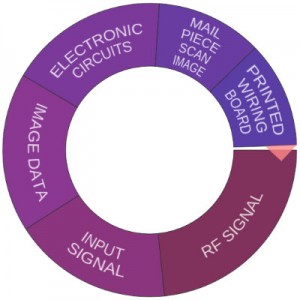 satellites. Despite a dip in third quarter earnings for Lockheed’s space division, the company reported that its space business was doing better than expected this far through 2015.
satellites. Despite a dip in third quarter earnings for Lockheed’s space division, the company reported that its space business was doing better than expected this far through 2015.
The Lockheed Martin Corporation does file quite a few of its technologies with the U.S. Patent and Trademark Office and last year earned 263 U.S. patents, tying it for 138th place with Bridgestone Corp. (TYO:5108) of Tokyo and United Microelectronics Corp. (NYSE:UMC) of Taiwan. In the third quarter, Lockheed earned 77 U.S. patents, according to data collected from Innography’s patent portfolio analysis tools. As the text cluster posted here will show readers, Lockheed’s recent research and development pursuits have focused pretty evenly on radio frequency signals, input signals, image data and electronic circuits.
Lockheed’s Issued Patents: From Underwater Mine Detection to Orbit Control for Thruster Failure
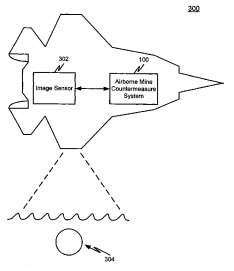 We certainly aren’t surprised to see a defense contractor filing patents for military technologies but were were intrigued to explore a trio of patents recently issued to Lockheed in this field. U.S. Patent No. 9092866, titled Airborne Mine Countermeasures, protects an airborne underwater mine countermeasure system operable aboard an aircraft and including a processor coupled to a memory storing instructions that are executable to obtain image input data of a body of water from an external image sensor, extract a sequence of 2D slices from the image input data by applying diffusion equations, perform a 3D connected region analysis on the sequence of 2D slices to analyze volumetric pixel elements, compute 3D invariant features in the image data and perform coarse filtering based on the 3D invariant features to output an image having an indication of the presence of any underwater mines. This technology is designed to produce less false positives than conventional underwater mine detection systems utilizing 2D matched filter analysis techniques.
We certainly aren’t surprised to see a defense contractor filing patents for military technologies but were were intrigued to explore a trio of patents recently issued to Lockheed in this field. U.S. Patent No. 9092866, titled Airborne Mine Countermeasures, protects an airborne underwater mine countermeasure system operable aboard an aircraft and including a processor coupled to a memory storing instructions that are executable to obtain image input data of a body of water from an external image sensor, extract a sequence of 2D slices from the image input data by applying diffusion equations, perform a 3D connected region analysis on the sequence of 2D slices to analyze volumetric pixel elements, compute 3D invariant features in the image data and perform coarse filtering based on the 3D invariant features to output an image having an indication of the presence of any underwater mines. This technology is designed to produce less false positives than conventional underwater mine detection systems utilizing 2D matched filter analysis techniques.
Battlefield technologies that will better equip military operatives for response to enemy tactics are 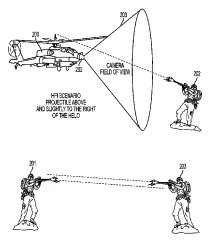 featured within U.S. Patent No. 9146251, entitled System, Method, and Computer Program Product for Indicating Hostile Fire. This patent discloses a method for indicating hostile fire by electronically detecting infrared radiation of a projectile in a field of view (FOV), electronically determining a travel path of the projectile based on the detected infrared radiation, electronically calculating a miss distance of the projectile based on electronically stored data for multiple projectile types and electronically outputting an indication of the projectile. This system is designed to quickly determine if an incoming projectile has a high likelihood of hitting a vehicle target. Ballistic missile defense systems are at the center of U.S. Patent No. 9140784, titled Ballistic Missile Debris Mitigation. It protects a method for an identification of launched objects obscured by debris objects within a debris field by directing sensor pulses at the debris field to obtain a plurality of sensor images, identifying objects within the debris field based on the sensor images, determining accelerating characteristics for each of the identified objects, identifying objects exhibiting free fall acceleration as the debris objects and identifying objects exhibiting centripetal acceleration as launched objects. This innovation is intended for use in naval battle theaters for tactical operations against short- and mid-range ballistic missile threats.
featured within U.S. Patent No. 9146251, entitled System, Method, and Computer Program Product for Indicating Hostile Fire. This patent discloses a method for indicating hostile fire by electronically detecting infrared radiation of a projectile in a field of view (FOV), electronically determining a travel path of the projectile based on the detected infrared radiation, electronically calculating a miss distance of the projectile based on electronically stored data for multiple projectile types and electronically outputting an indication of the projectile. This system is designed to quickly determine if an incoming projectile has a high likelihood of hitting a vehicle target. Ballistic missile defense systems are at the center of U.S. Patent No. 9140784, titled Ballistic Missile Debris Mitigation. It protects a method for an identification of launched objects obscured by debris objects within a debris field by directing sensor pulses at the debris field to obtain a plurality of sensor images, identifying objects within the debris field based on the sensor images, determining accelerating characteristics for each of the identified objects, identifying objects exhibiting free fall acceleration as the debris objects and identifying objects exhibiting centripetal acceleration as launched objects. This innovation is intended for use in naval battle theaters for tactical operations against short- and mid-range ballistic missile threats.
Augmented realities are always an interesting sector of innovation and we thought readers might be interested to explore Lockheed’s immersion technology for training programs, outlined in U.S. Patent No. 9098939, which is titled System and Method of Generating Light Maps. It discloses a method of constructing a luminance terrain map of a region of interest by accessing region imagery of the region of interest, accessing lineal data that identifies the location of a plurality of roads in the region imagery, accessing area data identifying the location of urban areas in the region imagery, selecting a plurality of spatial areas of imagery depicting roads and an urban area and generating the luminance terrain light map providing a bright light pool image region. This immersive technology is designed to support more realistic training simulations, including weather and time of day elements, while increasing the speed at which it takes to develop a light map for simulations; conventional methods take about three months.
Autonomous vehicles have been a huge focus for us this year and we took some time to look more closely into U.S. Patent No. 9120568, titled Autonomous Resupply System and Method. It claims a vehicle for transporting a load and having at least one sensor that receives a first modulated direction signal from beacons attached to two guide rails of a loading station, at least one load line to carry the load and at least one controller 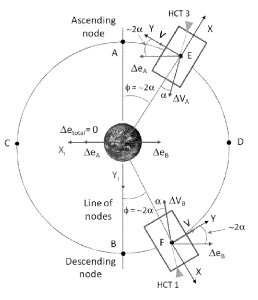 configured to receive sensor output, determine the direction from which the modulated direction signal was transmitted, control the vehicle’s position based on the determination and determine a destination unloading station. This innovation takes a great deal of risk out of potentially dangerous resupply missions for military operations or natural disaster response.
configured to receive sensor output, determine the direction from which the modulated direction signal was transmitted, control the vehicle’s position based on the determination and determine a destination unloading station. This innovation takes a great deal of risk out of potentially dangerous resupply missions for military operations or natural disaster response.
As we noted above, Lockheed is involved in innovating for space exploration and we took a closer look at one detailed within U.S. Patent No. 9114890, titled Thruster Orbit Control Method and Configuration. It protects a stationkeeping method for a spacecraft having an X-axis, a Y-axis and a Z-axis by firing thrusters of a spacecraft at one orbit position and firing other spacecraft thrusters at a second orbit position and, in the instance that a single thruster fails, firing the first thruster at a calculated third orbit position and the second thruster at a calculated fourth orbit position. This orbit control method can propel a spacecraft with only a nominal reduction in efficiency if a single thruster fails.
Patent Applications of Note: Better Deep Sea Anchors and Crime Scene DNA Evidence Collection
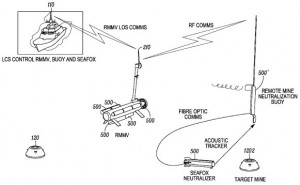 Lockheed isn’t content with simply detecting underwater mines to judge by the filing of U.S. Patent Application No. 20150225049, which is titled Apparatus and Method for Neutralizing Underwater Mines. It would protect a method for neutralizing an undersea mine by locating an undersea mine, placing a buoy containing a mine neutralizer near the mine, deploying the mine neutralizer from the buoy and directing the mine neutralizer to the undersea mine. This innovation improves upon the efficiency of neutralizing undersea mines over conventional methods involving the use of helicopters. Undersea technologies developed by Lockheed Martin are also the focus of U.S. Patent Application No. 20150233079, which is titled Undersea Anchoring System and Method. It discloses a method of anchoring an object to a seabed by disposing a support structure on the seabed floor, disposing a seabed drill on the support structure, driving a first pile anchor into the seabed floor using the drill, pumping grout around the first pile anchor, moving the seabed drill linearly to a second position, driving a second pile anchor into the seabed floor at the second position using the drill, pumping grout around the second pile anchor and connecting the object to be anchored to both pile anchors. This system for anchoring vessels in deep waters in a way that is more cost-effective than gravity anchors and bored pile anchors with mooring lines above the seabed.
Lockheed isn’t content with simply detecting underwater mines to judge by the filing of U.S. Patent Application No. 20150225049, which is titled Apparatus and Method for Neutralizing Underwater Mines. It would protect a method for neutralizing an undersea mine by locating an undersea mine, placing a buoy containing a mine neutralizer near the mine, deploying the mine neutralizer from the buoy and directing the mine neutralizer to the undersea mine. This innovation improves upon the efficiency of neutralizing undersea mines over conventional methods involving the use of helicopters. Undersea technologies developed by Lockheed Martin are also the focus of U.S. Patent Application No. 20150233079, which is titled Undersea Anchoring System and Method. It discloses a method of anchoring an object to a seabed by disposing a support structure on the seabed floor, disposing a seabed drill on the support structure, driving a first pile anchor into the seabed floor using the drill, pumping grout around the first pile anchor, moving the seabed drill linearly to a second position, driving a second pile anchor into the seabed floor at the second position using the drill, pumping grout around the second pile anchor and connecting the object to be anchored to both pile anchors. This system for anchoring vessels in deep waters in a way that is more cost-effective than gravity anchors and bored pile anchors with mooring lines above the seabed.
More battlefield technology is at the center of U.S. Patent Application No. 20150285597, titled Armor Having Prismatic, Tesselated Core. It discloses an armor comprising a core configured with two layers of prismatic elements arranged in a tessellated fashion, an explosive material, a computing device, a sensor, an optical fiber, an antenna element and an electrical wire associated with an armor component and elements of both prismatic layers. This innovation is designed to provide protection to military and police vehicles from ballistics damage.
An intriguing system for providing visual data to operators of an aircraft is at the center of U.S. Patent Application No. 20150241221, filed under the title Projected Synthetic Vision. This patent application would protect a system including sensors, a terrain database, a projected synthetic vision controller coupled to the sensors and the terrain database to generate and project synthetic vision images based on position, terrain information and boresight information provided by vehicle operators. This invention is intended to serve as a projected synthetic vision system for aircraft operators, providing them with topographical imagery to make a landing in an area with which they’re unfamiliar.
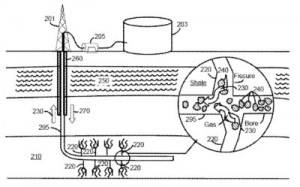 More effective sensor technology to prevent the contamination of natural aquifers from hydraulic fracturing techniques employed for natural gas extraction is discussed within U.S. Patent Application No. 20150268373, titled Mapping and Monitoring of Hydraulic Fractures Using Vector Magnetometers. It claims a method for mapping and monitoring of hydraulic fractures by capturing a first magnetic image of a well pay zone, capturing a second magnetic image after a well bore is padded with a fluid, establishing a background based on both magnetic images, capturing a third magnetic image after a doped proppant is injected into a stage and processing the third image to subtract the background and obtain information regarding distribution of the fluid and the proppant in the stage. This technology is capable of mapping out induced fracture networks to obtain information regarding the proximity of fractures to underground features such as aquifers or fault lines.
More effective sensor technology to prevent the contamination of natural aquifers from hydraulic fracturing techniques employed for natural gas extraction is discussed within U.S. Patent Application No. 20150268373, titled Mapping and Monitoring of Hydraulic Fractures Using Vector Magnetometers. It claims a method for mapping and monitoring of hydraulic fractures by capturing a first magnetic image of a well pay zone, capturing a second magnetic image after a well bore is padded with a fluid, establishing a background based on both magnetic images, capturing a third magnetic image after a doped proppant is injected into a stage and processing the third image to subtract the background and obtain information regarding distribution of the fluid and the proppant in the stage. This technology is capable of mapping out induced fracture networks to obtain information regarding the proximity of fractures to underground features such as aquifers or fault lines.
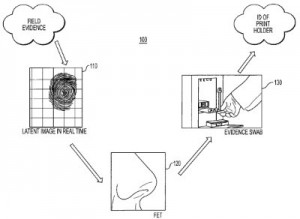 Better methods of collecting DNA evidence directly from crime scenes are detailed within U.S. Patent Application No. 20150225783, which is titled Nondestructive Collection of Evidence. It claims a method of capturing a print by illuminating a latent print on a foundation with a light, adjusting a frequency and an angle of reflection of the light to provide maximum specular reflection and minimum diffused reflection of the light from the latent print and capturing a resulting image of the latent print in contrast to the foundation. This provides a method for collecting DNA evidence at a scene and not handling evidence for processing at a lab which takes additional time and can lead to the degradation of the evidence’s forensic value. Finally, we were interested in taking a closer look at a technology designed for collecting latent fingerprints, described within U.S. Patent Application No. 20150227773, titled Latent Fingerprint Detectors and Fingerprint Scanners Therefrom. It would protect a latent fingerprint detection system including a first light source illuminating a sample surface to produce specular reflection from the sample surface, an optical detector arranged at a critical alignment angle relative to the first light source to capture specular reflection from the sample surface and generates image data using the specular reflection and an image processor that analyzes the generated image data to determine if it includes a fingerprint and produces image data of the fingerprint in response to the determination of the fingerprint. This contactless form of collecting crime scene evidence obviates the dilemma that investigators have in making the decision whether to dust for fingerprints or swab for DNA evidence, either of which degrades the evidence that is collected by the other technique.
Better methods of collecting DNA evidence directly from crime scenes are detailed within U.S. Patent Application No. 20150225783, which is titled Nondestructive Collection of Evidence. It claims a method of capturing a print by illuminating a latent print on a foundation with a light, adjusting a frequency and an angle of reflection of the light to provide maximum specular reflection and minimum diffused reflection of the light from the latent print and capturing a resulting image of the latent print in contrast to the foundation. This provides a method for collecting DNA evidence at a scene and not handling evidence for processing at a lab which takes additional time and can lead to the degradation of the evidence’s forensic value. Finally, we were interested in taking a closer look at a technology designed for collecting latent fingerprints, described within U.S. Patent Application No. 20150227773, titled Latent Fingerprint Detectors and Fingerprint Scanners Therefrom. It would protect a latent fingerprint detection system including a first light source illuminating a sample surface to produce specular reflection from the sample surface, an optical detector arranged at a critical alignment angle relative to the first light source to capture specular reflection from the sample surface and generates image data using the specular reflection and an image processor that analyzes the generated image data to determine if it includes a fingerprint and produces image data of the fingerprint in response to the determination of the fingerprint. This contactless form of collecting crime scene evidence obviates the dilemma that investigators have in making the decision whether to dust for fingerprints or swab for DNA evidence, either of which degrades the evidence that is collected by the other technique.

![[IPWatchdog Logo]](https://ipwatchdog.com/wp-content/themes/IPWatchdog%20-%202023/assets/images/temp/logo-small@2x.png)


![[[Advertisement]]](https://ipwatchdog.com/wp-content/uploads/2023/01/2021-Patent-Practice-on-Demand-1.png)
![[Advertisement]](https://ipwatchdog.com/wp-content/uploads/2024/04/Artificial-Intelligence-2024-REPLAY-sidebar-700x500-corrected.jpg)
![[Advertisement]](https://ipwatchdog.com/wp-content/uploads/2024/04/UnitedLex-May-2-2024-sidebar-700x500-1.jpg)
![[Advertisement]](https://ipwatchdog.com/wp-content/uploads/2024/04/Patent-Litigation-Masters-2024-sidebar-700x500-1.jpg)

![[Advertisement]](https://ipwatchdog.com/wp-content/uploads/2021/12/WEBINAR-336-x-280-px.png)
![[Advertisement]](https://ipwatchdog.com/wp-content/uploads/2021/12/2021-Patent-Practice-on-Demand-recorded-Feb-2021-336-x-280.jpg)
![[Advertisement]](https://ipwatchdog.com/wp-content/uploads/2021/12/Ad-4-The-Invent-Patent-System™.png)






Join the Discussion
No comments yet.